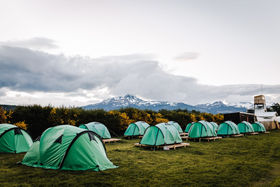Unser Angebot
Wir untersützen Sie in den Bereichen Reisen, Erholung und Erleben - nach Ihren individuellen Bedürfnissen, entsprechend Ihrer eigenen Vorstellungen und Wünschen mit unseren ganz persönlichen Tipps und Empfehlungen - zum Gelingen Ihres einmaligen Patagonien-Erlebnisses.
Unser Angebot
Wir untersützen Sie in den Bereichen Reisen, Erholung und Erleben - nach Ihren individuellen Bedürfnissen, entsprechend Ihrer eigenen Vorstellungen und Wünschen mit unseren ganz persönlichen Tipps und Empfehlungen - zum Gelingen Ihres einmaligen Patagonien-Erlebnisses.
Unser Angebot
Wir untersützen Sie in den Bereichen Reisen, Erholung und Erleben - nach Ihren individuellen Bedürfnissen, entsprechend Ihrer eigenen Vorstellungen und Wünschen mit unseren ganz persönlichen Tipps und Empfehlungen - zum Gelingen Ihres einmaligen Patagonien-Erlebnisses.
Unser Angebot
Wir untersützen Sie in den Bereichen Reisen, Erholung und Erleben - nach Ihren individuellen Bedürfnissen, entsprechend Ihrer eigenen Vorstellungen und Wünschen mit unseren ganz persönlichen Tipps und Empfehlungen - zum Gelingen Ihres einmaligen Patagonien-Erlebnisses.
Die Story
Wir - Marina & Christian - vereinen die Werte der argentinischen und deutschen Kultur und wollen unsere Passion für die Region Patagonien durch ein Höchstmaß an Authentizität und Vertrauen an unsere Partner und Kunden weitergeben. Dafür stehen wir mit unseren Werten.
Wir untersützen Sie in den Bereichen Reisen, Erholung und Erleben nach Ihrem individuellen Bedarf entsprechend Ihrer eigenen Vorstellungen und Wünschen mit unseren ganz persönlichen Tipps und Empfehlungen.
Wir untersützen Sie in den Bereichen Reisen, Erholung und Erleben nach Ihrem individuellen Bedarf entsprechend Ihrer eigenen Vorstellungen und Wünschen mit unseren ganz persönlichen Tipps und Empfehlungen.
Wir untersützen Sie in den Bereichen Reisen, Erholung und Erleben nach Ihrem individuellen Bedarf entsprechend Ihrer eigenen Vorstellungen und Wünschen mit unseren ganz persönlichen Tipps und Empfehlungen.
Wir untersützen Sie in den Bereichen Reisen, Erholung und Erleben nach Ihrem individuellen Bedarf entsprechend Ihrer eigenen Vorstellungen und Wünschen mit unseren ganz persönlichen Tipps und Empfehlungen.
Unsere Story
Unsere Story
Wir untersützen Sie in den Bereichen Reisen, Erholung und Erleben nach Ihrem individuellen Bedarf entsprechend Ihrer eigenen Vorstellungen und Wünschen mit unseren ganz persönlichen Tipps und Empfehlungen.
PatagonIA
Epic landscapes with spectacular panoramas in untouched nature, surrounded by enormous glaciers, turquoise blue lagoons, rugged peaks and a flora and fauna unique on our earth - all this describes the wild Patagonia, that region south of the rivers Rio Colorado in Argentina and Rio Bio Bio in Chile, embracing the southern extension of the Andes to Tierra del Fuego, the southernmost end of the world.

Fascination
For many, the special fascination of Patagonia lies in its huge distance from everything we know. Everyone associates different sensations, impressions and images with their first thoughts of Patagonia. Most, however, revolve primarily around nature: mountains, rivers, seas and fjords are our places of longing, where pumas, condors, whales and penguins live beyond human civilization.
Facts
Nearly 2 million people live on about 1 million km². "Patagonia" describes a region that includes five Argentine provinces (Neuquén, Rio Negro, Chubut, Santa Cruz, Tierra del Fuego) as well as the Chilean Palena province and the Chilean regions Aisén and Magallanes. The most significant mountains are Mount FitzRoy (3406m) and Torres del Paine (3050m), the most famous national parks are PN Torres del Paine (UNESCO protection since 1978), PN Tierra del Fuego, PN Los Glaciares (UNESCO protection since 1981), Peninsula Valdés (UNESCO protection since 1999).
History
This primeval world experienced its most recent serious break with the arrival of the first humans about 15,000 years ago. Tehuelche, Mapuche, Chonos, Selknam, Yahgan and Halakwalup are the names of the peoples and tribes that shared the region now known as Patagonia for thousands of years in Stone Age civilization as hunter-gatherers. They lived isolated in harmony with nature until Fernando Magellan discovered them as the first European on his circumnavigation of the world in 1521 and gave their homeland the name "Patagonia" (land of the giant feet). The "Strait of Magellan", which he crossed, connects the Atlantic with the Pacific and from then on represented the western route from Europe to Asia. Numerous other expeditions and the first settlers followed, but all succumbed to the extreme climatic conditions. It was not until the 19th century, with the creation of the two states of Argentina and Chile and the subsequent division of the Patagonia region between them, that systematic settlement began, mainly with European colonists. Thus, the Welsh, the English, the Germans and the French sought their fortune in the new world. Even today, the European influence can be experienced in Patagonia. With the discovery of oil and the increasing accessibility for tourists in the course of the 20th century, the Patagonia region has gained enormously in importance, but without losing its originality.
For more information about the geography of Patagonia and more details about its most important places, click here.
Click through the picture gallery and immerse yourself in the fascination of Patagonia!
.png)
























